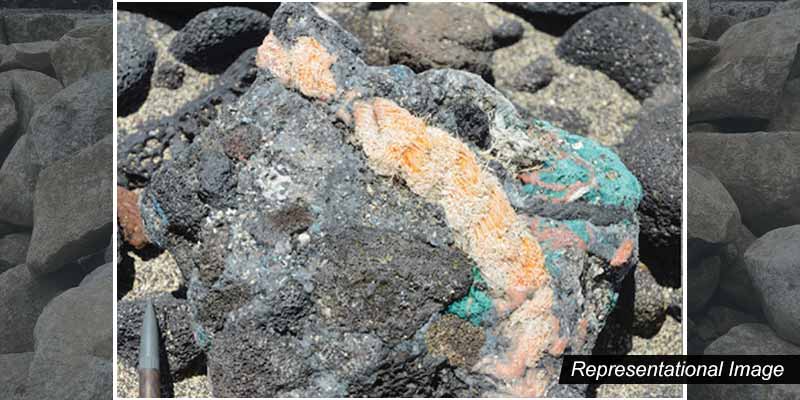- World
- Mar 20
What is plastiglomerate?
• The discovery of rocks made from plastic debris in Brazil’s volcanic Trindade Island is sparking alarm.
• Melted plastic has become intertwined with rocks on the island, located 1,140 km from the southeastern state of Espirito Santo.
• Fernanda Avelar Santos, a geologist at the Federal University of Parana, and her team ran chemical tests to find out what kind of plastics are in the rocks called “plastiglomerates”, because they are made of a mixture of sedimentary granules and other debris held together by plastic.
• The pollution mainly comes from fishing nets, which is very common debris on Trindade Island’s beaches. The nets are dragged by the marine currents and accumulate on the beach. When the temperature rises, this plastic melts and becomes embedded with the beach's natural material.
• Trindade Island is one of the world’s most important conservation spots for green turtles (Chelonia mydas), with thousands arriving each year to lay their eggs.
• The only human inhabitants on Trindade are members of the Brazilian navy, which maintains a base on the island and protects the nesting turtles.
What is plastiglomerate?
• Plastiglomerate is a material that describes rock fragments, sand grains, plastic debris and organic materials (such as shells, wood and coral debris) held together in a matrix of once-molten plastic
• These anthropogenic ‘stones’ were first reported on Kamilo Beach, Hawaii in 2014, but have since been identified in many coastal locations.
• Plastiglomerate is not a rock. Rocks are formed naturally, whereas plastiglomerate is composed of anthropogenic products (plastic) shaped by anthropogenic processes or actions (burning).
• Plastiglomerate is a symptom of the plastic pollution crisis.
Plastic menace
• Plastic was first invented in 1907, and given that it was cheaper and more convenient than other materials, it soon found use in varied ways in our daily lives.
• Today, plastic is present in almost everything, from our money to electronic appliances, and it is used across multiple sectors, including packaging, building, construction, transportation, industrial machinery and health among others.
• However, the lack of sustainable plastic waste management (PWM) poses a serious threat to our environment and natural ecosystem globally.
• Data indicates that while a large quantum of plastic waste is generated, low levels of it are sustainably managed and discarded worldwide.
• From 1950 to 2015, around 8.3 billion metric tonnes (BMTs) of plastic had been produced globally, and of this, 80 per cent – 6.3 BMTs – was accounted as plastic waste.
• Of these 6.3 BMTs of waste, only 9 per cent was recycled, 12 per cent incinerated and 79 per cent dumped into landfills, oceans or waterbodies.
• Various manufacturing industries across the globe produce 400 million tonnes of plastic waste per year, with the packaging industry being the largest contributor. According to a report by FICCI, 40 per cent of the packaging needs in India are fulfilled using plastic.
• Globally, plastic pollution has emerged as a serious menace in the absence of streamlined PWM focusing on reuse, reduction, and recycling of plastic waste.
Campaign to beat plastic pollution
• In March 2022, heads of State, environment ministers and other representatives from 175 nations, endorsed a historic resolution at the UN Environment Assembly in Nairobi to end plastic pollution, and forge an international legally binding agreement, by the end of 2024.
• The impacts of plastic production and pollution on the triple planetary crisis of climate change, nature loss and pollution are a catastrophe in the making with exposure to plastics harming human health, and potentially affecting fertility, hormonal, metabolic and neurological activity, while open burning of plastics contributes to air pollution.
• By 2050, greenhouse gas emissions associated with plastic production, use and disposal, would account for 15 per cent of allowed emissions, under the goal of limiting global warming to 1.5°C in line with the Paris Agreement on climate change.
• More than 800 marine and coastal species are affected by this pollution through ingestion, entanglement, and other dangers.
• Around 11 million tonnes of plastic waste flow each year into the ocean. This could triple by 2040.
• A shift to a circular economy can reduce the volume of plastics entering oceans by over 80 per cent by 2040, reduce virgin plastic production by 55 per cent, save governments $70 billion by 2040, reduce greenhouse gas emissions by 25 per cent, and create 700,000 additional jobs – mainly in the global south.
Manorama Yearbook app is now available on Google Play Store and iOS App Store


